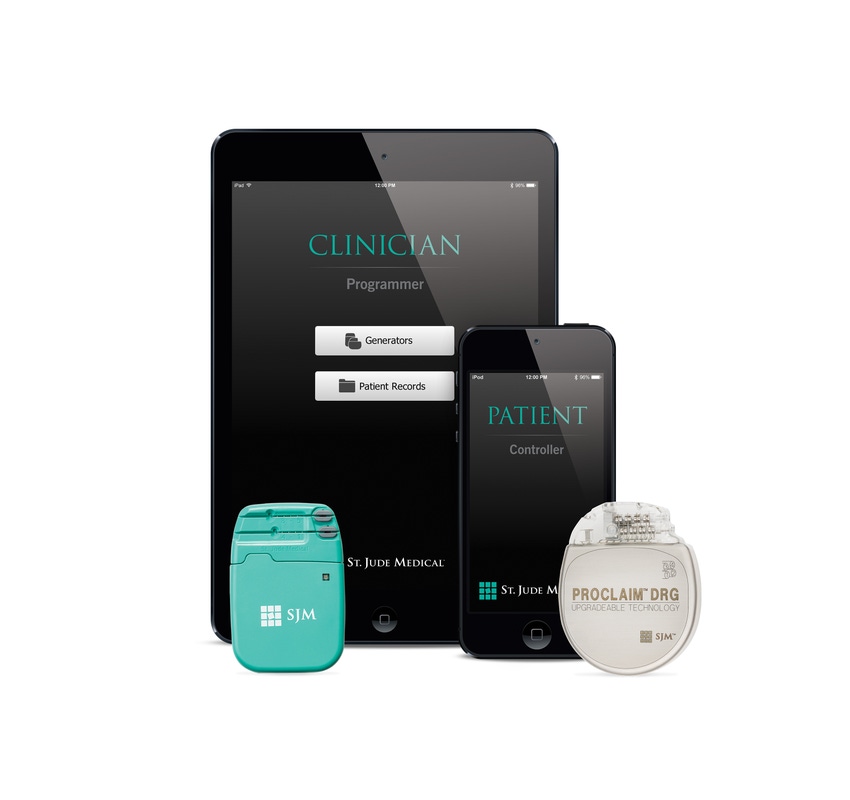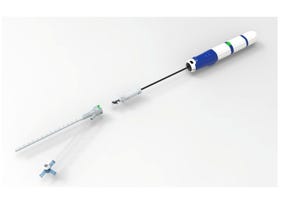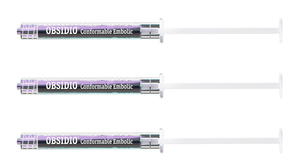Users can get a trial run of the neuromodulation therapy before having the Proclaim DRG system implanted.
November 19, 2018

Abbott Laboratories has nabbed approvals for a chronic pain treatment device that patients can try before getting an implanted version of the technology. The Dorsal Root Ganglion (DRG) Invisible Trial System now has CE mark and a nod from FDA. The Abbott Park, IL-based company said patients who find adequate pain relief with DRG therapy can then have the Proclaim DRG System implanted.
The Proclaim DRG includes an implantable neuromodulator that stimulates the dorsal root ganglion (DRG), an Apple iPad for programming the device, and an iPod touch for the patient control of the device.
“Abbott's DRG Invisible Trial System is very much focused on the person who is seeking pain relief,” Allen Burton, M.D., medical director of neuromodulation, at Abbott told MD+DI. “This evaluation period can give insight into whether the technology will provide meaningful relief to people who have oftentimes tried many failed therapies previously. This unique ability to “test drive” the procedure before committing to fully implanted therapy is an important part of our patient-centric DRG therapy.”
Here’s how the technology works. During a minimally invasive outpatient procedure, thin wires are placed in the spinal column near the DRG and a small, external battery is hidden discreetly under clothes. Not only is that the "invisible" aspect to the technology, it is also the ability for the patient to go along with their daily activities without bulky medical cables and by using consumer friendly Apple technology. For about a week, the patient uses an iPod touch to manage their pain relief—changing the stimulation settings within prescribed limits to evaluate how DRG therapy targets their body's chronic pain symptoms.
Burton said the DRG Trial Invisible System is not meant to be a replacement for Proclaim.
“No, the evaluation period is meant to allow people to try the therapy for a limited time per FDA indications,” Burton said. “This “test drive” of the therapy allows the patient and their physician to make the best decision regarding proceeding to permanent DRG implant while being discreet and “invisible” to their family and friends.”
Abbott has built up strong data showing off the effectiveness of its DRG pain relief technology.
The ACCURATE study demonstrated that DRG therapy can provide superior pain relief when compared to traditional spinal cord stimulation therapy for people with persistent neuropathic focal pain conditions, such as complex regional pain syndrome (CRPS). In a sub-analysis of this data, over 90% of patients reached success with the implanted dorsal root ganglion stimulator device (data presented at North American Neuromodulation Society 2015). In addition to the ACCURATE study, more than 10 published studies worldwide over the last four years demonstrate excellent outcomes in more than 500 patients.
The device could be another tool to help stem the tide of opioid abuse.
“While prescription opioid medication can play an important role in helping manage acute (short-term) or cancer pain, these drugs were never intended to routinely treat chronic (long-term) pain,” Burton said. “Even today, there is a lack of evidence for such extended use. Neurostimulation therapy is a drug-free technology to manage chronic pain. There is great potential to improve outcomes by implanting a neurostimulator earlier, before chronic opioid use. One study (Sharan, 2017) showed that with neurostimulation patients could reduce or stabilize their opioid use.”
About the Author(s)
You May Also Like




